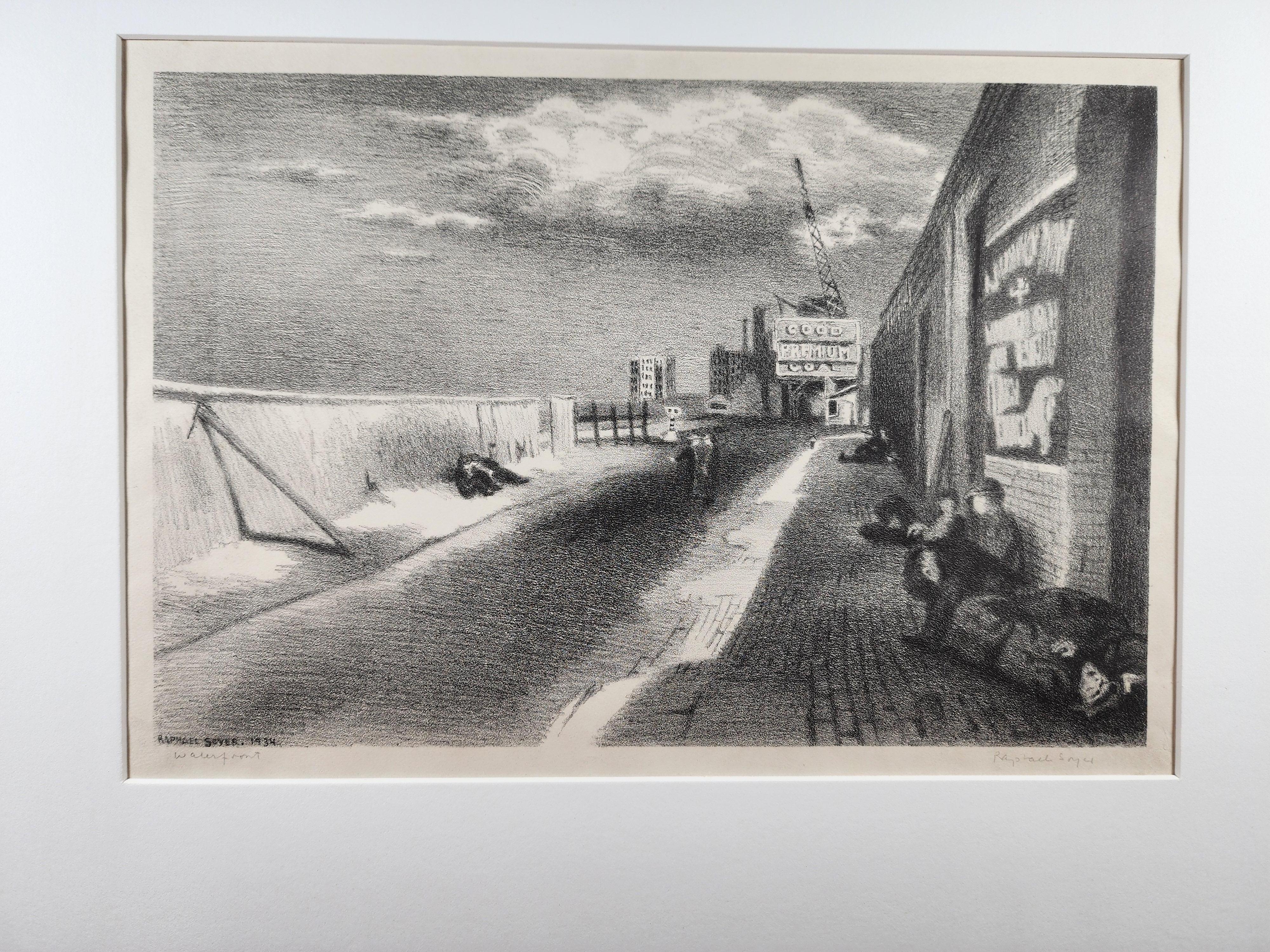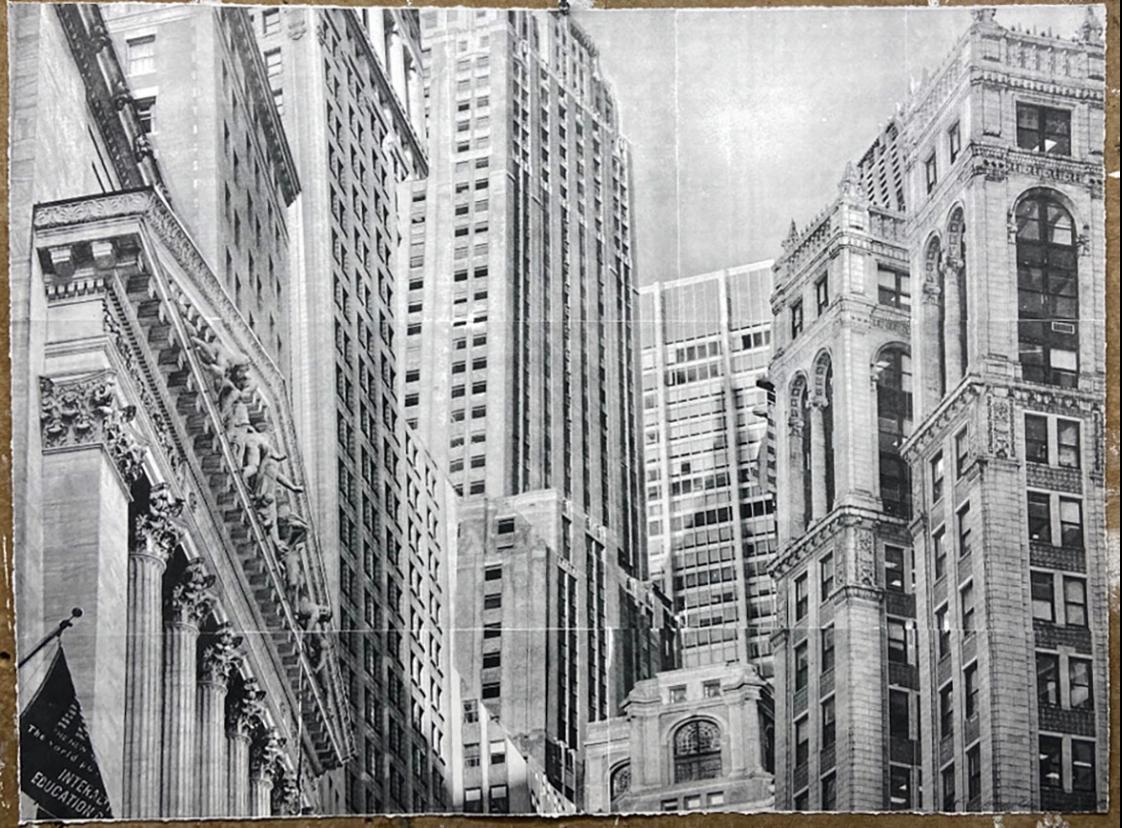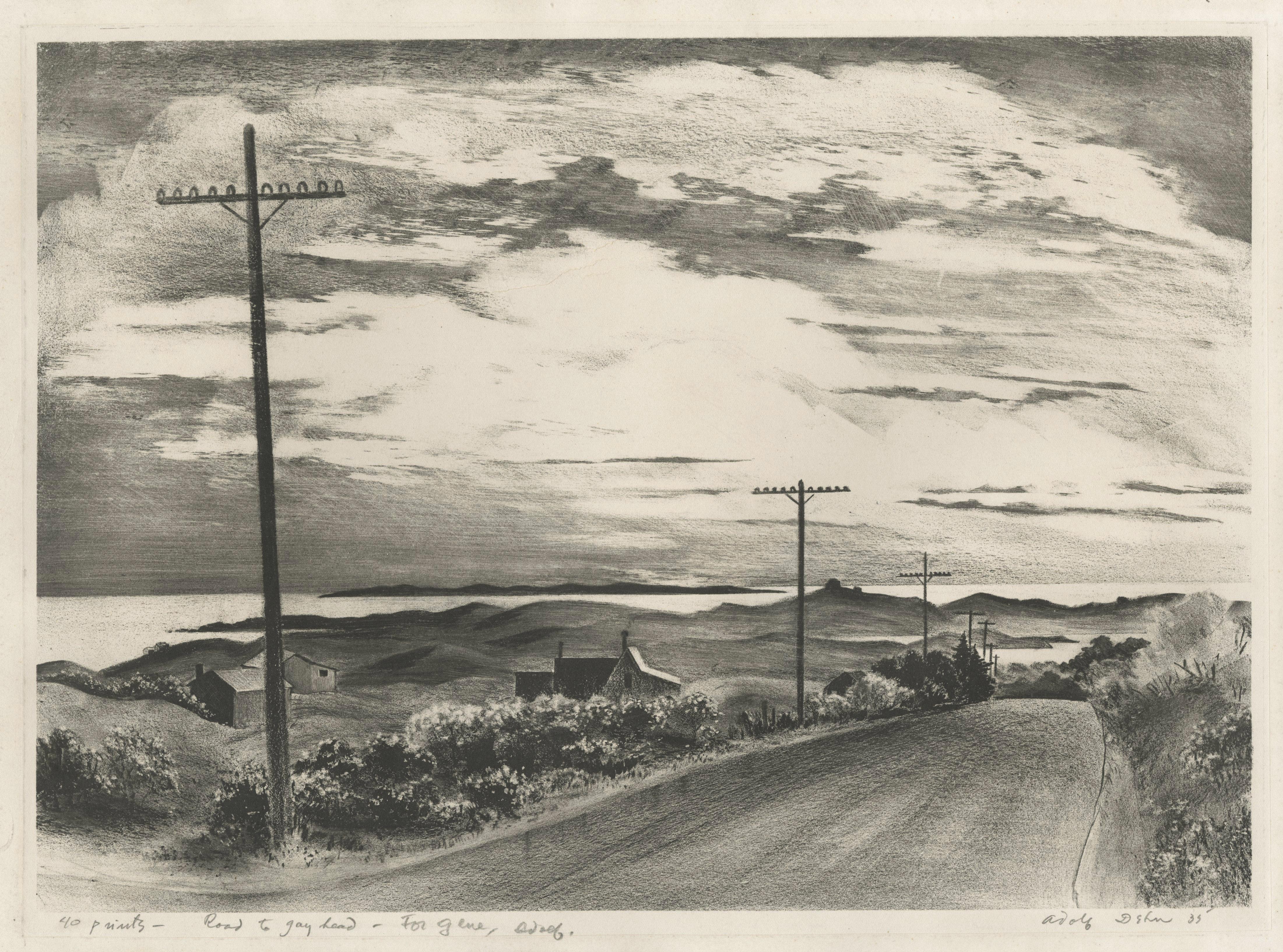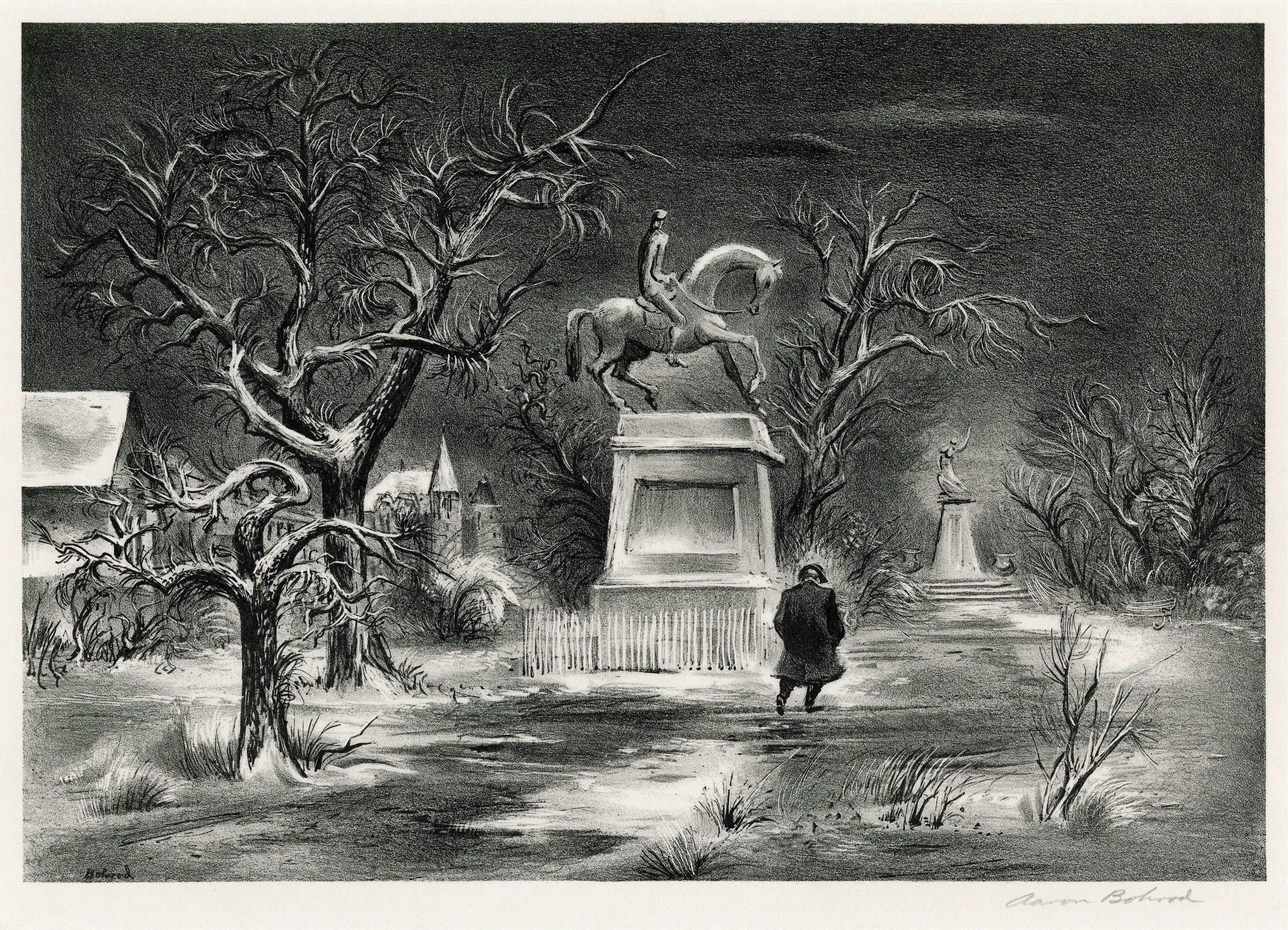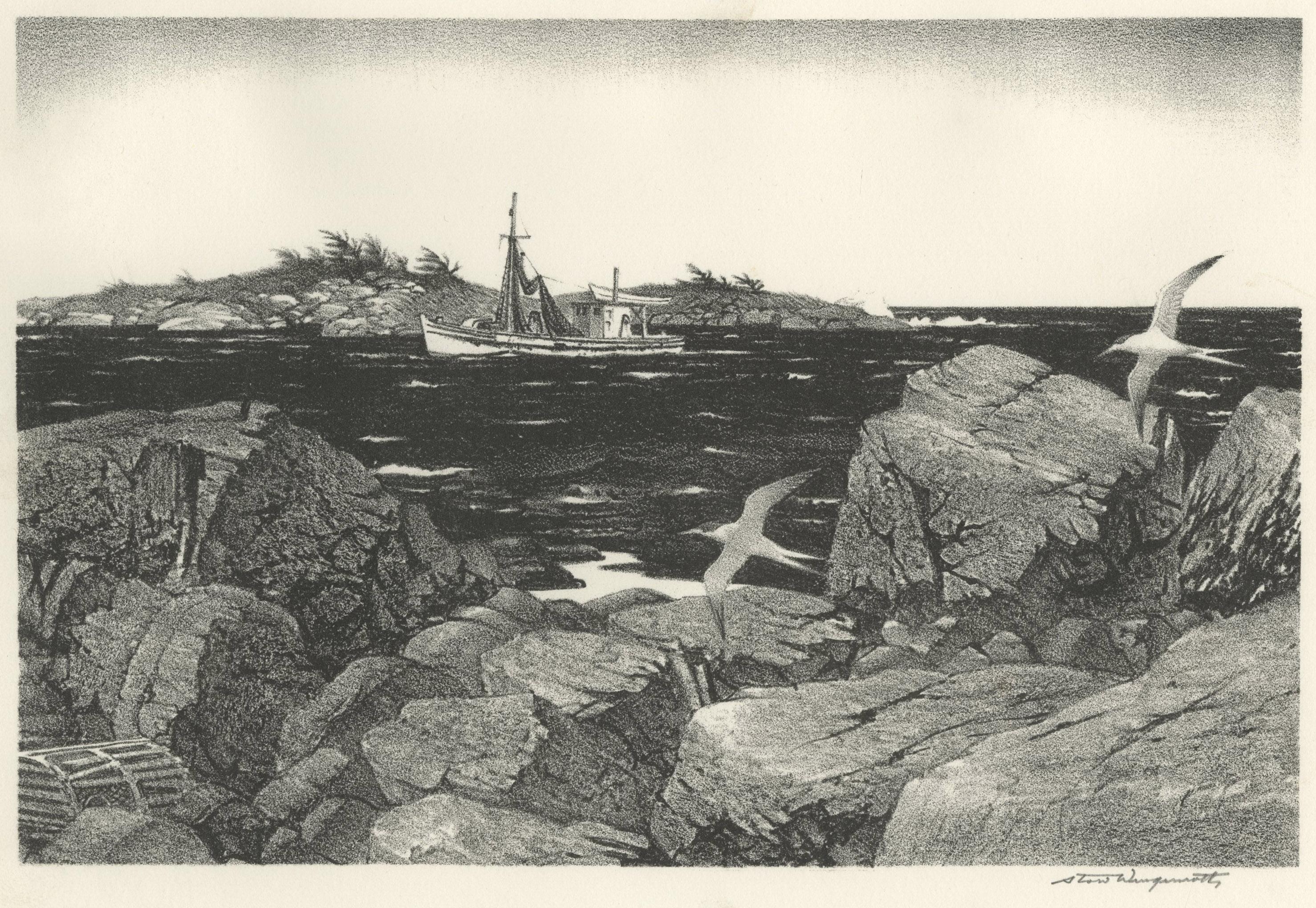Items Similar to New York Skyline, Sketch
Want more images or videos?
Request additional images or videos from the seller
1 of 3
John Taylor ArmsNew York Skyline, Sketch1921
1921
About the Item
A fine impression, on cream wove paper, with full margins (5/8 to 1 3/8 inches), in excellent condition. Edition 20. Signed and dated in pencil. Annotated 'Bolton Brown - imp.' in pencil by the printer. Very scarce.
A view of lower Manhattan from the East River with the iconic Woolworth Building, at the time the tallest building in the world, towering over the New York City skyline.
Impressions of this work are in the permanent collections of the Cleveland Museum of Art, Library of Congress, National Gallery of Art.
- Creator:John Taylor Arms (1887 - 1953, American)
- Creation Year:1921
- Dimensions:Height: 6.82 in (17.33 cm)Width: 5 in (12.7 cm)
- Medium:
- Movement & Style:
- Period:
- Condition:
- Gallery Location:Myrtle Beach, SC
- Reference Number:
About the Seller
5.0
Recognized Seller
These prestigious sellers are industry leaders and represent the highest echelon for item quality and design.
Platinum Seller
These expertly vetted sellers are 1stDibs' most experienced sellers and are rated highest by our customers.
Established in 1995
1stDibs seller since 2016
254 sales on 1stDibs
Typical response time: 2 hours
Associations
International Fine Print Dealers Association
- ShippingRetrieving quote...Ships From: Myrtle Beach, SC
- Return PolicyA return for this item may be initiated within 7 days of delivery.
More From This SellerView All
- 'Threshing' — 1940s American RegionalismBy Thomas Hart BentonLocated in Myrtle Beach, SCThomas Hart Benton, 'Threshing', lithograph, 1941, edition 250, Fath 48. Signed in pencil. Signed in the stone, lower left. A fine, richly-inked impression, on off-white, wove paper, with full margins (1 3/8 to 1 5/8 inches), in excellent condition. Published by Associated American Artists. Image size 9 5/16 x 13 13/16 inches (237 x 351 mm); sheet size 12 1/2 x 16 5/8 inches (318 x 422 mm). Archivally matted to museum standards, unframed. Impressions of this work are held in the following museum collections: Art Institute of Chicago, Fine Arts Museums of San Francisco, High Museum of Art, McNay Art Museum, Montgomery Museum of Fine Arts, and Nelson-Atkins Museum of Art. ABOUT THE ARTIST “Benton’s idiom was essentially political and rhetorical, the painterly equivalent of the country stump speeches that were a Benton family tradition. The artist vividly recalled accompanying his father, Maecenas E. Benton — a four-term U.S. congressman, on campaigns through rural Missouri. Young Tom Benton grew up with an instinct for constituencies that led him to assess art on the basis of its audience appeal. His own art, after the experiments with abstraction, was high-spirited entertainment designed to catch and hold an audience with a political message neatly bracketed between humor and local color.” —Elizabeth Broun “Thomas Hart Benton: A Politician in Art,” Smithsonian Studies in American Art, Spring 1987, p. 61 Born in 1889 in Neosho, Missouri, Benton spent much of his childhood and adolescence in Washington, D.C., where his lawyer father, Maecenas Eason Benton, served as a Democratic member of Congress from 1897 to 1905. Hoping to groom him for a political career, Benton’s father sent him to Western Military Academy. After nearly two years at the academy, Benton convinced his mother to support him through two years at the Art Institute of Chicago, followed by two more years at the Academie Julian in Paris. Benton returned to America in 1912 and moved to New York to pursue his artistic career. One of his first jobs was painting sets for silent movies, which were being produced in Fort Lee, New Jersey. Benton credits this experience with giving him the skills he needed to make his large-scale murals. When World War I broke out, Benton joined the Navy. Stationed in Norfolk, Virginia, he was assigned to create drawings of the camouflaged ships arriving at Norfolk Naval Station. The renderings were used to identify vessels should they be lost in battle. Benton credited being a ‘camofleur’ as having a profound impact on his career. “When I came out of the Navy after the First World War,” he said, “I made up my mind that I wasn’t going to be just a studio painter, a pattern maker in the fashion then dominating the art world–as it still does. I began to think of returning to the painting of subjects, subjects with meanings, which people, in general, might be interested in.” While developing his ‘regionalist’ vision, Benton also taught art, first at a city-supported school and then at The Art Students League (1926–1935). One of his students was a young Jackson Pollock, who looked upon Benton as a mentor and a father figure. In 1930, Benton was commissioned to paint a mural for the New School for Social Research. The ‘America Today’ mural, now on permanent exhibit at the Metropolitan Museum of Art, was followed by many more commissions as Benton’s work gained acclaim. The Regionalist Movement gained popularity during the Great Depression of the 1930s. Painters, including Benton, Grant Wood, and John Steuart Curry, rejected modernist European influences preferring to depict realistic images of small-town and rural life—reassuring images of the American heartland during a period of upheaval. Time Magazine called Benton 'the most virile of U.S. painters of the U.S. Scene,' featuring his self-portrait on the cover of a 1934 issue that included a story about 'The Birth of Regionalism.' In 1935, Benton left New York and moved back to Missouri, where he taught at the Kansas City Art Institute. Benton’s outspoken criticism of modern art, art critics, and political views alienated him from many influencers in political and art scenes. While remaining true to his beliefs, Benton continued to create murals, paintings, and prints of some of the most enduring images of American life. The dramatic and engaging qualities of Benton’s paintings and murals attracted the attention of Hollywood producers. He was hired to create illustrations and posters for films, including his famous lithographs for the film adaptation of John Steinbeck’s ‘Grapes of Wrath’ produced by Twentieth Century Fox. Benton’s work can be found at the Art Institute of Chicago, High Museum of Art, Fine Arts Museums of San Francisco, Library of Congress, McNay Art Museum, Metropolitan Museum of Art, Minneapolis Institute of Arts, Montgomery Museum of Fine Arts, National Gallery of Art, Nelson-Atkins Museum of Art, Smithsonian American Art Museum, Whitney Museum of American Art, The Truman Library and many other museums and galleries across the US. He was elected to the National Academy of Design, has illustrated many books, authored his autobiography, and is the subject of ‘Thomas Hart Benton,’ a documentary by Ken Burns.Category
1940s American Realist Figurative Prints
MaterialsLithograph
- 'Cleveland Public Square' — 1920s Urban RealismBy Anton SchutzLocated in Myrtle Beach, SCAnton Schutz, 'Cleveland Public Square', etching, edition not stated, 1927. Signed in pencil. Signed and dated in the plate, lower left. Annotated 'Cleveland Public Square S489', in another hand, in the bottom right margin. A fine, richly-inked impression, in brown/black ink, with skillfully-controlled plate tone, on cream wove Japan paper; the full sheet with margins (1 5/8 to 3 inches), in excellent condition. Archivally sleeved, unmatted. Image size 11 7/8 x 8 7/8 inches; sheet size 17 1/4 x 12 1/8 inches. ABOUT THIS IMAGE 'Public Square' is the two-block (formerly four-block) central plaza of downtown Cleveland, Ohio. Based on an 18th-century New England model, it was part of the original 1796 town plan overseen by Moses Cleveland and remains today as an integral part of the city's center. The 10-acre (4.0 ha) square is centered on the former intersection of Superior Avenue and Ontario Street.[2] Cleveland's three tallest buildings, Key Tower, 200 Public Square, and the Terminal Tower, face the square. Public Square was part of the Connecticut Land Company's original plan for the city, overseen by Moses Cleveland in the 1790s. The square is signature of the layout for early New England towns, which Cleveland was modeled after. While it initially served as a common pasture for settlers' animals, less than a century later in 1879 Public Square became the first street in the world to be lit with electric street lights—arc lamps designed by Cleveland native Charles F. Brush. The square was added to the National Register of Historic Places on December 18, 1975. Public Square is often the site of political rallies and civic functions, including a free annual Independence Day concert by the Cleveland Orchestra...Category
1920s American Realist Landscape Prints
MaterialsEtching
- 'Heart of San Francisco' — Vintage 1920s RealismBy Anton SchutzLocated in Myrtle Beach, SCAnton Schutz, 'Heart of San Francisco', etching, c. 1927, edition not stated. Signed in pencil. A superb, richly-inked impression, on cream wove paper; the full sheet with margins (2...Category
1920s American Realist Landscape Prints
MaterialsEtching
- 'Westminster Abbey' — 1920s RealismBy Anton SchutzLocated in Myrtle Beach, SCAnton Schutz, 'Westminster Abbey', etching, edition not stated, 1927. Signed in pencil. Signed and dated in the plate, lower left. A superb, richly-i...Category
1920s American Realist Landscape Prints
MaterialsEtching
- 12th Street Walls — 1940s New York CityBy Armin LandeckLocated in Myrtle Beach, SCArmin Landeck, '12th Street Walls', etching, edition 100, first state, 1944, Kraeft 93. Signed in pencil. Initialed in the plate lower left. A superb, early impression, with all the ...Category
1940s American Realist Landscape Prints
MaterialsDrypoint
- 'Gloucester Harbor 2' — Mid-Century East Coast RegionalismLocated in Myrtle Beach, SCLawrence Nelson Wilbur, 'Gloucester Harbor', drypoint, 1940. Signed, dated, and titled in pencil. Signed in the plate, lower right. Annotated 'PERSONAL...Category
1940s American Realist Landscape Prints
MaterialsDrypoint
You May Also Like
- WaterfrontBy Raphael SoyerLocated in Raleigh, NCExcellent condition and matted with archival materials. An excellent addition to any New York or WPA collection.Category
1930s American Realist Landscape Prints
MaterialsLithograph
- Wall Street 2, black & white 25.5" X 36" lithograph abstract urban street NYCLocated in Brooklyn, NYWall Street 2 - plate size 25.5 x 36 - printed on 100% cotton rag - edition 3/5 monochromatic city-scape w/ Architectural elements Cubist and abstract assemblage photographic characterCategory
2010s American Realist Landscape Prints
MaterialsArchival Ink, Archival Paper, Rag Paper, Lithograph
- Wall Street 1, 25.5 x 36 inches, black/white lithograph, abstract urban city NYLocated in Brooklyn, NYWall Street 2 - plate size 25.5 x 36 - printed on 100% cotton rag - edition 3/5 monochromatic city-scape w/ Architectural elements Cubist and abstract assemblage photographic characterCategory
Early 2000s American Realist Landscape Prints
MaterialsArchival Ink, Archival Paper, Rag Paper, Lithograph
- Road to Gayhead (Martha's Vinyard)By Adolf DehnLocated in Fairlawn, OHRoad to Gayhead (Martha's Vineyard) Lithograph, 1935 Signed, dated. editoned & titled in pencil Printer: George Miller, New York A famous view of Martha's Vinyard Illustrated: Adams, Fig. 10.14, Page 234 Edition: 40 Printed chine collee Annotated: "For Gene" Reference: Lumsdaine & O'Sullivan 293 Incorporated in 1870. Aquinnah is the center of the Wampanoag Tribe of Gay Head Aquinnah. A Federally recognized Native American People. It is located at the tip of Martha's Vinyard. The Wampanoag Tribe of Gay Head Aquinnah became a federally acknowledged tribe on April 10, 1987 through the Bureau of Indian Affairs. The Tribe is preserving its history, culture and language. The town was called Gay Head until 1997 when the Tribe won the right to change the name of the town back to the original Wampanoag name. The smallest town on the Island at 5.4 miles of land area. The drive to Aquinnah is beautiful. You will notice that the three down-Island towns, Vineyard Haven, Oak Bluffs...Category
1930s American Realist Landscape Prints
MaterialsLithograph
- City Park, WinterBy Aaron BohrodLocated in Fairlawn, OHCity Park, Winter Lithograph, c. 1947 Signed in pencil lower right (see photo) Published by Associated American Artists Printed by George C. Miller, New York Edition: c. 250 In the Bohrod papers at Syracuse University, the artist states that it is a view of Pittsburgh. It depicts the George Washington Monument in Allegheny Commons Park, dedicated in 1891. The sculptor f the monument is Edward Ludwig Albert Pausch (1856-1931). Condition: Excellent Image size: 9 1/4 x 13 7/16 inches Frame size: 19 x 23 inches Provenance: Estate of Adolf Dehn Reference: AAA Index No. 848 Aaron Bohrod (21 November 1907 – 3 April 1992) was an American artist best known for his trompe-l'œil still-life paintings. Education Bohrod was born in Chicago in 1907, the son of an emigree Bessarabian-Jewish grocer. Bohrod studied at the School of the Art Institute of Chicago and the Art Students League of New York between 1926 and 1930. While at the Art Students League, Bohrod was influenced by John Sloan and chose themes that involved his own surroundings. Career He returned to Chicago in 1930 where he painted views of the city and its working class. He eventually earned Guggenheim Fellowships which permitted him to travel throughout the country, painting and recording the American scene. His early work won him widespread praise as an important social realist and regional painter and printmaker and his work was marketed through Associated American Artists in New York. Bohrod completed three commissioned murals for the Treasury Departments Section of Fine Arts in Illinois; Vandalia in 1935, Galesburg in 1938 and Clinton in 1939. During World War II, Bohrod worked as an artist; first in the Pacific for the United States Army Corps of Engineers' Army War Art Unit...Category
1940s American Realist Landscape Prints
MaterialsLithograph
- New England Coast (Greenport, New York)By Stow WengenrothLocated in Fairlawn, OHNew England Coast (Greenport, New York) Lithograph, 1969 Signed in pencil lower right (see photo) Edition: 350 Published in the book, Stow Wengenroth...Category
1960s American Realist Landscape Prints
MaterialsLithograph
